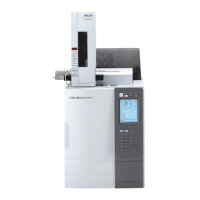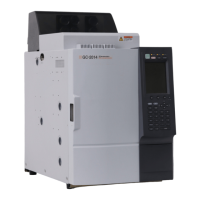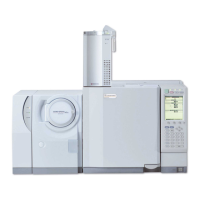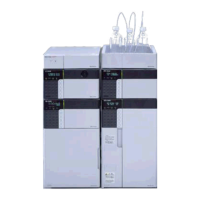6 Analysis Flow Chart
6.1 Analysis Flow Chart
68
GC-2010 Plus
Q Sample injection modes
[Split injection]
In capillary columns, the inner diameter is small and the sample load capacity is low. Unlike
packed columns, only a small (less than 0.1 µL) amount of sample can be injected at one-
time. The split injection mode only allows part of the injected sample to enter the column.
This method is useful for samples of high consentration or about which nothing is known.
Try to perform a split injection method first. Set the split ratio to approximately 1:50 for the narrow bore
column (ex. 0.25 mm I.D.). If the target peak is too large, increase the split ratio. If the target peak is
too small or cannot be detected, decrease the split ratio. Select a proper split ratio in this way.
The standard to set the split ratio is [column flow rate + split ratio] ≧ 30 ml. The value varies
depending on the columns' inner diameter and flow rate. It is recommended to start with the
total flow rate of approximately 50 ml.
If the desired sensitivity cannot be achieved at [column flow rate + split ratio] < 20 ml,
consider other injection methods.
[Splitless injection]
In the splitless injection method, almost all of the sample amount injected is introduced in the
column by temporarily suspending the split flow.
This method is effective for analyzing a low concentration sample which cannot be easily
detected by the split injection method.
To reduce band broadening and sharpen peaks by condensation and vaporization of the
sample in the column, create a temperature ramp program. The column initial temperature is
set to a temperature lower than the boiling point of the sample solvent.
The high pressure injection can reduce the volume of vaporized sample solution and
improve the analysis repeatability.
[Direct injection]
In the direct injection method, almost the entire amount of injected sample is introduced into
a wide bore column. Because the inner diameter of the wide bore column is 0.45 mm or
more, separation is not as good as that of a column with smaller inner diameter. Because
the peak shape is broad, sensitivity may not be good enough.
For the direct injection method, the WBI (Wide Bore Injection) injection port is required.
Column nut
for injection port
Ferrule adjuster
Ferrule
Injection port
Thermal insulation cup
Ferrule
Column nut
Detector
Ferrule adjuster Injection port column installation Detector column installation
34 mm
15 mm
In the case of
splitless analysis
with wide bore
column
FID: 69 mm
TCD: 50 mm

